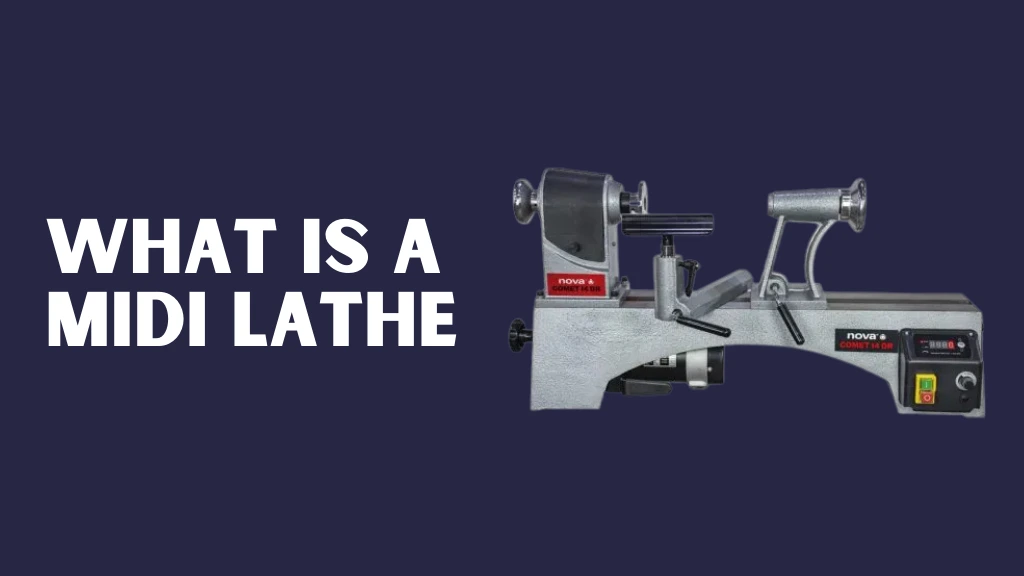Woodturning has grown in popularity among hobbyists, artists, and small business owners who want to transform blocks of wood into beautiful, functional, and decorative items. Whether it is a handcrafted bowl, a custom pen, or a set of chair legs, the lathe is the central machine that makes these creations possible. A midi lathe spins a workpiece at high speeds, allowing tools to carve, shape, and refine wood into precise forms.
Among the many types of lathes available, the mid sized lathe has earned a special reputation. It is widely praised for combining the portability of smaller machines with the power and stability of full-sized equipment. In many ways, it provides the best of both worlds. This article explains in detail what is a midi lathe, its design, specifications, benefits, uses, and differences compared to other lathes. We will also explore real-world applications, maintenance practices, costs, and safety considerations so you can make an informed choice.
What is a Midi Lathe
A midi lathe is essentially a mid-sized wood lathe, positioned between compact mini lathes and large full-sized models. It typically provides a swing capacity of around 12 to 14 inches, which makes it suitable for turning medium bowls and platters. The bed length usually falls within 16 to 24 inches, offering enough space for spindles, handles, and chair legs. Motors in this category generally range from half a horsepower to one and a half horsepower, giving woodworkers the strength required to handle most hardwoods with ease.
Weighing between 80 and 120 pounds, the machine strikes a balance between portability and stability. It is heavy enough to minimize vibration during use, yet still light enough to be transported when necessary. This combination of strength, size, and flexibility explains why it has become a favorite among both hobbyists and professional woodworkers.
Understanding the Basics
for small projects such as pens, ornaments, or delicate spindles. On the opposite end, full-sized lathes are much larger, with swings exceeding 16 inches and bed lengths over 36 inches. These heavy-duty machines can handle furniture legs, oversized bowls, or even large structural pieces, but they demand a significant investment and plenty of workshop space.
The midi lathe sits comfortably between these two extremes. It delivers greater capacity than a mini model while remaining far more manageable than a full-sized machine. This balance is exactly why many woodworkers select it as their first serious investment or even as their main tool. Beginners value its ease of use and affordability, while seasoned turners appreciate the power and versatility it provides for a wide variety of projects. For anyone asking what is a midi lathe, the answer lies in this balance of size, performance, and accessibility.
Key Specifications
The specifications of a lathe play a major role in determining what types of projects it can handle. In mid-sized models, the bed length usually ranges between 16 and 24 inches. This length gives woodworkers enough space to work on items like rolling pins, furniture spindles, and table legs. It strikes a balance between compactness and functionality, making it suitable for both hobbyists and professionals.
Swing capacity is another important measurement to consider. With about 12 to 14 inches of swing, these machines can turn bowls and platters that exceed the limits of smaller mini versions. At the same time, they avoid the bulk and power demands of full-sized lathes. This makes them versatile for projects that fall in the medium range, from decorative pieces to practical household items.
Motor power provides the strength behind the tool’s performance. Most models feature between half a horsepower and one and a half horsepower, which is enough to work with both softwoods and harder materials like oak, cherry, or maple. Many also come with variable speed controls, typically ranging from 250 to 4,000 revolutions per minute. Some even include a digital display for monitoring exact speeds.
Stability is equally essential for safe and accurate turning. Weighing between 80 and 120 pounds, these machines are heavy enough to reduce vibration but still light enough to move if necessary. This combination of steadiness and portability makes them a great fit for home workshops, garages, or small studios. It ensures that users get reliable performance without requiring a permanent industrial setup.
Benefits of Using a Midi Lathe
The advantages of this mid-sized machine come from its balance of size, strength, and convenience. Unlike compact mini models, which are limited in capacity, it can manage both delicate and moderately large projects with ease. Its compact form ensures that it fits comfortably in smaller workshops or garages. At the same time, it retains the motor power and stability necessary for serious woodturning.
Affordability is another strong benefit that attracts many users. While large, full-sized lathes often cost several thousand dollars, a midi lathe usually ranges between five hundred and fifteen hundred dollars. This price point makes it accessible for hobbyists, students, and even small business owners. By offering professional-level performance at a reasonable cost, it fills an important gap in the market.
Durability also plays a key role in its popularity. Many models are constructed with heavy cast iron frames, which help to reduce vibration and improve overall stability during operation. This solid build not only improves accuracy but also ensures long-term reliability. Owners often find that these machines provide years of dependable service with minimal maintenance.
Finally, the accessibility of this tool is worth emphasizing. Beginners appreciate that it is simple enough to learn on without feeling overwhelmed. At the same time, experienced woodworkers value its precision, power, and adaptability for advanced projects. This combination of user-friendliness and professional capability makes it one of the most versatile tools in any woodworking shop.
Common Uses
A midi lathe supports an impressive variety of woodworking projects, making it a favorite among both beginners and professionals. Many hobbyists start with pen turning, bottle stoppers, or ornaments, as its precision and manageable size make learning straightforward. For those ready to expand, the same machine can handle medium-sized bowls and platters that highlight the natural beauty and unique grain of wood.
Beyond decorative pieces, this tool is equally effective for functional projects. Woodworkers frequently craft chair legs, spindles, balusters, and custom tool handles with ease. Its ability to balance strength and control allows users to experiment with different wood species, from soft pine to dense maple or oak. This versatility ensures that projects are not limited by material or design complexity.
The value of a mid-sized lathe is also evident in real-world workshops. In many small businesses and training programs, it serves as a dependable primary machine, delivering both accuracy and durability at a reasonable cost. With its mix of practicality and artistic potential, it empowers woodworkers to build skills, produce high-quality items, and trust in a machine that can grow with them over time.
Midi vs Mini vs Full-Size Lathes
When comparing different types of lathes, the differences become clear. A mini lathe is affordable and portable but limited in project size. A full-sized lathe offers enormous capacity and power but demands significant space and financial investment.
The midi lathe stands in the middle. It is strong enough to turn medium bowls and furniture parts while remaining compact enough to fit in smaller workshops. This balance explains why many woodworkers view this lathe as the most practical choice, especially if they want one machine that can handle both hobby-level and small business production work.
Features to Look for When Buying
When selecting a midi lathe, build quality should be a top consideration. Cast iron construction minimizes vibration and ensures stability. Speed range is equally important, with variable controls allowing greater flexibility depending on the type of project. While some models feature digital readouts for speed, this is an added convenience rather than a necessity.
Alignment between the tailstock and headstock should be precise, as misalignment can lead to inaccuracies. Brand reliability also matters. Well-known manufacturers such as Jet, Delta, Rikon, Nova, and Laguna are respected for producing durable, user-friendly machines. Finally, warranty length can be a good indicator of quality. A company willing to back its product for several years demonstrates confidence in its durability.
Top Brands and Models (2025 Update)
Several midi lathes have earned strong reputations within the woodworking community for their reliability and performance. The Jet JWL-1221VS, for instance, is often highlighted in reviews for its variable speed control and exceptional stability, making it a trusted choice for both beginners and professionals. Its consistent performance has been praised by hobbyists on woodworking forums and in trade publications.
The Delta 46-460 stands out for its powerful one-horsepower motor and reversible function, which ensures smoother finishes on turned pieces. Professionals value this model because it delivers the torque needed for dense hardwoods while remaining accessible to serious hobbyists. Rikon’s 70-220VSR, meanwhile, offers a more budget-friendly entry point, providing accurate results without compromising build quality, which has helped it gain popularity in schools and training programs.
For those with limited space, Nova’s Comet II DR is compact yet versatile, making it especially appealing for home workshops. On the premium end, the Laguna Revo 1216 combines a solid cast-iron build with digital controls, offering precision that appeals to advanced users who demand accuracy. These trusted brands, many of which are reviewed by woodworking professionals and rated highly on retail platforms, show how a well-chosen mid lathe can match both budget and skill level.
Real-World Experiences
The benefits of this machine are best understood through real-world applications. One hobbyist started with a Jet model, first turning pens and then moving on to bowls and decorative items. Thanks to the tool’s reliability and capacity, the individual gained confidence and eventually began selling handcrafted pieces online.
Another example comes from a small woodworking business owner who invested in a Delta midi lathe. By producing bowls, spindles, and custom furniture accents, the craftsman was able to build relationships with local boutique stores and create a steady source of income. These examples show how a well-chosen lathe can serve as both a personal creative outlet and a professional tool for growth.
Maintenance and Safety Tips
Proper maintenance is key to extending the lifespan of a lathe and ensuring consistent results. Removing dust and wood chips after each session prevents buildup that could affect accuracy over time. Lubricating moving components such as bearings and spindles keeps the machine running smoothly. Additionally, regularly sharpening cutting tools reduces the effort required and improves precision.
Safety is equally important and should never be overlooked. Wearing protective goggles, dust masks, and hearing protection minimizes exposure to potential hazards. Securing the workpiece firmly before starting helps prevent accidents, and monitoring vibration during use can alert woodworkers to mechanical issues early. These precautions protect both the user and the equipment.
Understanding what is a midi lathe is also involves recognizing the importance of proper care. By following recommended maintenance and safety practices, woodworkers can enjoy reliable performance, long-term durability, and consistent accuracy. Routine care ensures the machine remains a dependable tool for both beginners and experienced turners tackling a variety of projects.
Cost Breakdown
The price of this type of wood lathe varies based on brand, build quality, and included features. Entry-level machines generally range from five hundred to seven hundred dollars, making them an attractive option for beginners who want to learn the basics without a large upfront investment. They provide solid functionality while remaining budget-friendly.
Mid-range options, usually priced between eight hundred and twelve hundred dollars, offer enhanced stability and added features such as variable speed controls or sturdier frames. These models appeal to serious hobbyists and small workshop owners who need reliability for more demanding projects. Their balance of cost and performance makes them a popular choice.
High-end machines, often starting at thirteen hundred dollars and climbing higher, bring advanced digital controls, premium construction, and improved precision. Many professionals choose these models for long-term durability and efficiency. With such a wide range of price points, understanding what is a midi lathe is helps buyers see why it is considered one of the most versatile investments in woodworking, suitable for both casual turners and experienced craftsmen.
Conclusion
A midi lathe provides the perfect balance of portability, power, and affordability. It is compact enough for home workshops yet strong enough to create medium-sized furniture components and decorative items. For hobbyists and professionals alike, this tool offers versatility and durability without requiring the cost or space of a full-sized model.
For anyone wondering what is a midi lathe, the answer is clear: it is a mid-sized woodturning machine designed to handle a wide range of projects. From pens and bowls to furniture parts, it offers an ideal blend of accessibility and capability.
FAQs
What is the best project to start with?
A mid size lathe is ideal for creating bowls, platters, tool handles, and spindles. It balances size and power, making it suitable for a variety of woodworking tasks.
Can a mid lathe turn large bowls?
Yes. Many models can handle bowls up to fourteen inches in diameter, which covers most medium-sized turning projects.
Is a mid-sized wood lathe good for beginners?
It is an excellent choice for beginners. The machine is powerful enough to grow with a user’s skills while remaining simple to operate for those just starting out.
What accessories are recommended?
Accessories such as chucks, calipers, sharpening systems, and dust collection equipment improve efficiency and accuracy.
How long does a mid-sized wood lathe typically last?
With regular maintenance and proper care, a quality mid sized lathe can last more than a decade, even with frequent use.




